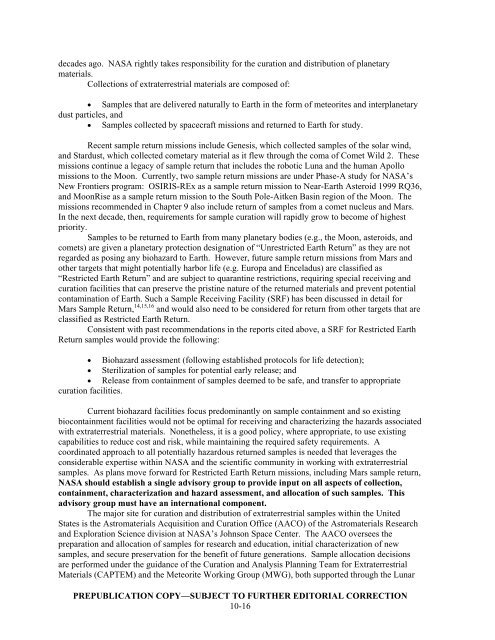Vision and Voyages for Planetary Science in the - Solar System ...
Vision and Voyages for Planetary Science in the - Solar System ...
Vision and Voyages for Planetary Science in the - Solar System ...
You also want an ePaper? Increase the reach of your titles
YUMPU automatically turns print PDFs into web optimized ePapers that Google loves.
decades ago. NASA rightly takes responsibility <strong>for</strong> <strong>the</strong> curation <strong>and</strong> distribution of planetary<br />
materials.<br />
Collections of extraterrestrial materials are composed of:<br />
• Samples that are delivered naturally to Earth <strong>in</strong> <strong>the</strong> <strong>for</strong>m of meteorites <strong>and</strong> <strong>in</strong>terplanetary<br />
dust particles, <strong>and</strong><br />
• Samples collected by spacecraft missions <strong>and</strong> returned to Earth <strong>for</strong> study.<br />
Recent sample return missions <strong>in</strong>clude Genesis, which collected samples of <strong>the</strong> solar w<strong>in</strong>d,<br />
<strong>and</strong> Stardust, which collected cometary material as it flew through <strong>the</strong> coma of Comet Wild 2. These<br />
missions cont<strong>in</strong>ue a legacy of sample return that <strong>in</strong>cludes <strong>the</strong> robotic Luna <strong>and</strong> <strong>the</strong> human Apollo<br />
missions to <strong>the</strong> Moon. Currently, two sample return missions are under Phase-A study <strong>for</strong> NASA’s<br />
New Frontiers program: OSIRIS-REx as a sample return mission to Near-Earth Asteroid 1999 RQ36,<br />
<strong>and</strong> MoonRise as a sample return mission to <strong>the</strong> South Pole-Aitken Bas<strong>in</strong> region of <strong>the</strong> Moon. The<br />
missions recommended <strong>in</strong> Chapter 9 also <strong>in</strong>clude return of samples from a comet nucleus <strong>and</strong> Mars.<br />
In <strong>the</strong> next decade, <strong>the</strong>n, requirements <strong>for</strong> sample curation will rapidly grow to become of highest<br />
priority.<br />
Samples to be returned to Earth from many planetary bodies (e.g., <strong>the</strong> Moon, asteroids, <strong>and</strong><br />
comets) are given a planetary protection designation of “Unrestricted Earth Return” as <strong>the</strong>y are not<br />
regarded as pos<strong>in</strong>g any biohazard to Earth. However, future sample return missions from Mars <strong>and</strong><br />
o<strong>the</strong>r targets that might potentially harbor life (e.g. Europa <strong>and</strong> Enceladus) are classified as<br />
“Restricted Earth Return” <strong>and</strong> are subject to quarant<strong>in</strong>e restrictions, requir<strong>in</strong>g special receiv<strong>in</strong>g <strong>and</strong><br />
curation facilities that can preserve <strong>the</strong> prist<strong>in</strong>e nature of <strong>the</strong> returned materials <strong>and</strong> prevent potential<br />
contam<strong>in</strong>ation of Earth. Such a Sample Receiv<strong>in</strong>g Facility (SRF) has been discussed <strong>in</strong> detail <strong>for</strong><br />
Mars Sample Return, 14,15,16 <strong>and</strong> would also need to be considered <strong>for</strong> return from o<strong>the</strong>r targets that are<br />
classified as Restricted Earth Return.<br />
Consistent with past recommendations <strong>in</strong> <strong>the</strong> reports cited above, a SRF <strong>for</strong> Restricted Earth<br />
Return samples would provide <strong>the</strong> follow<strong>in</strong>g:<br />
• Biohazard assessment (follow<strong>in</strong>g established protocols <strong>for</strong> life detection);<br />
• Sterilization of samples <strong>for</strong> potential early release; <strong>and</strong><br />
• Release from conta<strong>in</strong>ment of samples deemed to be safe, <strong>and</strong> transfer to appropriate<br />
curation facilities.<br />
Current biohazard facilities focus predom<strong>in</strong>antly on sample conta<strong>in</strong>ment <strong>and</strong> so exist<strong>in</strong>g<br />
bioconta<strong>in</strong>ment facilities would not be optimal <strong>for</strong> receiv<strong>in</strong>g <strong>and</strong> characteriz<strong>in</strong>g <strong>the</strong> hazards associated<br />
with extraterrestrial materials. None<strong>the</strong>less, it is a good policy, where appropriate, to use exist<strong>in</strong>g<br />
capabilities to reduce cost <strong>and</strong> risk, while ma<strong>in</strong>ta<strong>in</strong><strong>in</strong>g <strong>the</strong> required safety requirements. A<br />
coord<strong>in</strong>ated approach to all potentially hazardous returned samples is needed that leverages <strong>the</strong><br />
considerable expertise with<strong>in</strong> NASA <strong>and</strong> <strong>the</strong> scientific community <strong>in</strong> work<strong>in</strong>g with extraterrestrial<br />
samples. As plans move <strong>for</strong>ward <strong>for</strong> Restricted Earth Return missions, <strong>in</strong>clud<strong>in</strong>g Mars sample return,<br />
NASA should establish a s<strong>in</strong>gle advisory group to provide <strong>in</strong>put on all aspects of collection,<br />
conta<strong>in</strong>ment, characterization <strong>and</strong> hazard assessment, <strong>and</strong> allocation of such samples. This<br />
advisory group must have an <strong>in</strong>ternational component.<br />
The major site <strong>for</strong> curation <strong>and</strong> distribution of extraterrestrial samples with<strong>in</strong> <strong>the</strong> United<br />
States is <strong>the</strong> Astromaterials Acquisition <strong>and</strong> Curation Office (AACO) of <strong>the</strong> Astromaterials Research<br />
<strong>and</strong> Exploration <strong>Science</strong> division at NASA’s Johnson Space Center. The AACO oversees <strong>the</strong><br />
preparation <strong>and</strong> allocation of samples <strong>for</strong> research <strong>and</strong> education, <strong>in</strong>itial characterization of new<br />
samples, <strong>and</strong> secure preservation <strong>for</strong> <strong>the</strong> benefit of future generations. Sample allocation decisions<br />
are per<strong>for</strong>med under <strong>the</strong> guidance of <strong>the</strong> Curation <strong>and</strong> Analysis Plann<strong>in</strong>g Team <strong>for</strong> Extraterrestrial<br />
Materials (CAPTEM) <strong>and</strong> <strong>the</strong> Meteorite Work<strong>in</strong>g Group (MWG), both supported through <strong>the</strong> Lunar<br />
PREPUBLICATION COPY—SUBJECT TO FURTHER EDITORIAL CORRECTION<br />
10-16











